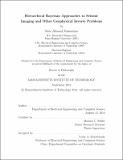Hierarchical Bayesian approaches to seismic imaging and other geophysical inverse problems
Author(s)
Zamanian, Sam Ahmad
DownloadFull printable version (24.68Mb)
Other Contributors
Massachusetts Institute of Technology. Department of Electrical Engineering and Computer Science.
Advisor
Michael C. Fehler.
Terms of use
Metadata
Show full item recordAbstract
In many geophysical inverse problems, smoothness assumptions on the underlying geologic model are utilized to mitigate the effects of poor data coverage and observational noise and to improve the quality of the inferred model parameters. In the context of Bayesian inference, these smoothness assumptions take the form of a prior distribution on the model parameters. Conventionally, the regularization parameters defining these assumptions are fixed independently from the data or tuned in an ad hoc manner. However, it is often the case that the smoothness properties of the true earth model are not known a priori, and furthermore, these properties may vary spatially. In the seismic imaging problem, for example, where the objective is to estimate the earth's reflectivity, the reflectivity model is smooth along a particular reflector but exhibits a sharp contrast in the direction orthogonal to the reflector. In such cases, defining a prior using predefined smoothness assumptions may result in posterior estimates of the model that incorrectly smooth out these sharp contrasts. In this thesis, we explore the application of Bayesian inference to different geophysical inverse problems and seek to address issues related to smoothing by appealing to the hierarchical Bayesian framework. We capture the smoothness properties of the prior distribution on the model by defining a Markov random field (MRF) on the set of model parameters and assigning weights to the edges of the underlying graph; we refer to these parameters as the edge strengths of the MRF. We investigate two cases where the smoothing is specified a priori and introduce a method for estimating the edge strengths of the MRF. In the first part of this thesis, we apply a Bayesian inference framework (where the edge strengths of the MRF are predetermined) to the problem of characterizing the fractured nature of a reservoir from seismic data. Our methodology combines different features of the seismic data, particularly P-wave reflection amplitudes and scattering attributes, to allow for estimation of fracture properties under a larger physical regime than would be attainable using only one of these data types. Through this application, we demonstrate the capability of our parameterization of the prior distribution with edge strengths to both enforce smoothness in the estimates of the fracture properties and capture a priori information about geological features in the model (such as a discontinuity that may arise in the presence of a fault). We solve the inference problem via loopy belief propagation to approximate the posterior marginal distributions of the fracture properties, as well as their maximum a posteriori (MAP) and Bayes least squares estimates. In the second part of the thesis, we investigate how the parameters defining the prior distribution are connected to the model covariance and address the question of how to optimize these parameters in the context of the seismic imaging problem. We formulate the seismic imaging problem within the hierarchical Bayesian setting, where the edge strengths are treated as random variables to be inferred from the data, and provide a framework for computing the marginal MAP estimate of the edge strengths by application of the expectation-maximization (E-M) algorithm. We validate our methodology on synthetic datasets arising from 2-D models. The images we obtain after inferring the edge strengths exhibit the desired spatially-varying smoothness properties and yield sharper, more coherent reflectors. In the final part of the thesis, we shift our focus and consider the problem of timelapse seismic processing, where the objective is to detect changes in the subsurface over a period of time using repeated seismic surveys. We focus on the realistic case where the surveys are taken with differing acquisition geometries. In such situations, conventional methods for processing time-lapse data involve inverting surveys separately and subtracting the inversion models to estimate the change in model parameters; however, such methods often perform poorly as they do not correctly account for differing model uncertainty between surveys due to differences in illumination and observational noise. Applying the machinery explored in the previous chapters, we formulate the time-lapse processing problem within the hierarchical Bayesian setting and present a framework for computing the marginal MAP estimate of the time-lapse change model using the E-M algorithm. The results of our inference framework are validated on synthetic data from a 2-D time-lapse seismic imaging example, where the hierarchical Bayesian estimates significantly outperform conventional time-lapse inversion results.
Description
Thesis: Ph. D., Massachusetts Institute of Technology, Department of Electrical Engineering and Computer Science, 2014. This electronic version was submitted by the student author. The certified thesis is available in the Institute Archives and Special Collections. Cataloged from student-submitted PDF version of thesis. Includes bibliographical references (pages 189-196).
Date issued
2014Department
Massachusetts Institute of Technology. Department of Electrical Engineering and Computer SciencePublisher
Massachusetts Institute of Technology
Keywords
Electrical Engineering and Computer Science.